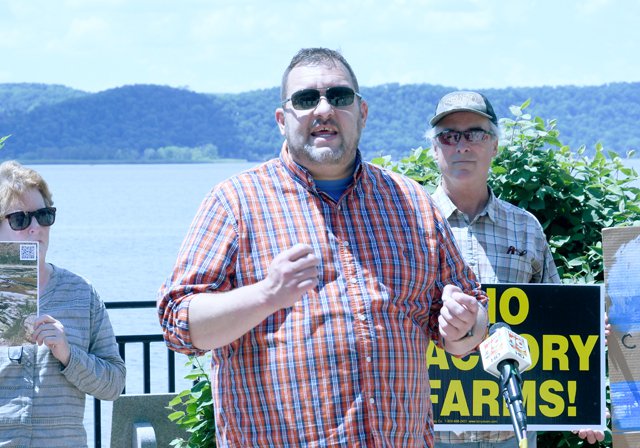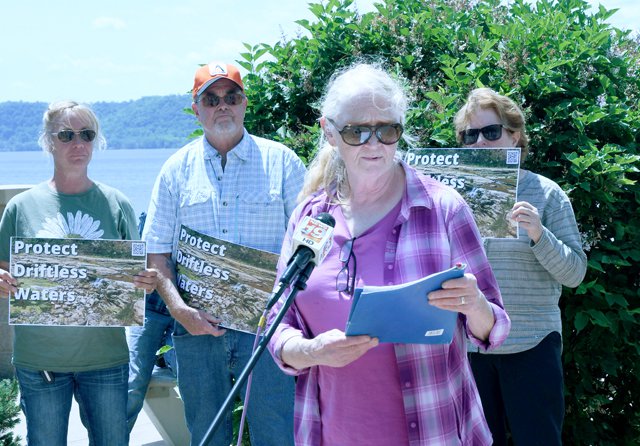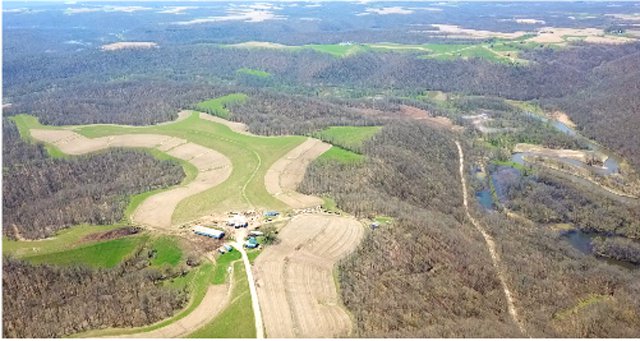MARIETTA TOWNSHIP - Roth Feeder Pigs, Crawford County’s only confined animal feeding operation (CAFO) is proposing to expand to a second facility in Marietta Township. On Tuesday, Citizen Action of Wisconsin (CAW) held an informational event attended by about 30 citizens in Ferryville, on the Mississippi River, facing Iowa.


Ben Wilson from CAW observed that Roth’s current and proposed new CAFO facilities is located above the Kickapoo River, and also just above the Wisconsin River.
“Any manure spill from the facility would send pollution into the Kickapoo River,” Wilson said. “And from there it would proceed into the Wisconsin River, and then into the Mississippi River.”


Forest Jahnke of the Crawford Stewardship Project observed that his organization has been monitoring surface water quality around the facility for over 10 years. They have also helped to pay for well testing, and monitored the nutrient management plan for the current Roth facility.
“AV Roth has too few spreadable acres to accommodate the manure from his operation,” Jahnke said. “Many of his spreadable acres are so high in phosphorous at this point, that no more manure should be spread there.”
Jahnke said that typically, to be sustainable, a livestock operation should have three-to-four acres per animal unit for spreading manure. He says that with the current nutrient overload on acres available to Roth Feeder Pigs for spreading, the facility has only between a quarter- to half-an-acre per animal unit.
Jahnke said that the overload of nutrients is best demonstrated from the results of monitoring spring water that comes out of the ground just below Roth’s current facility.
“What we have found, especially after large rain events, are high levels of phosphorous and E.coli in the spring water,” Jahnke said. “Spring water is groundwater coming to the surface, and what this means is that the aquifers near the current facility are already showing signs of pollution.”
Jahnke said that the WDNR has designated that part of the Kickapoo River as a ‘conservation opportunity area,’ and pointed out that just last year, the Lower Wisconsin Riverway had been designated a RAMSR wetlands of international significance.

Pam Saunders, representing Wisconsin Farmers Union (WFU), also shared her organization’s concerns with the proposed expansion.
“From its mission statement, WFU is committed to enhancing quality of life for family farmers, rural communities, and all people,” Saunders explained. “And from a 2021 policy document, WFU believes in the right to farm, but not the right to pollute or to harm neighbor’s rights.”
Saunders said that the WFU policy calls on the State of Wisconsin to re-evaluate whether the Livestock Siting Board is the best system for balancing the protection of farmers’ rights with the rights of the community and of the environment.
“We live in a state with an abundant water resource, so its no wonder that Wisconsin is seen almost as a new frontier for large confinement operations,” Saunders said. “Not only do we have abundant water, we have less experience with large confinement operations compared to states like Iowa or North Carolina. Those states have reaped the consequences of concentrated livestock and manure in the form of polluted surface and ground waters.”
Saunders says that WFU policy calls for proposals for very large livestock operations to be scrutinized individually – which is to say that an environmental impact study (EIS) is needed.
“No one set of standards, guidelines or rules can ever encompass all the potential environmental risks of a specific site,” Saunders explained. “Given the karst geology, the proximity to a major waterway, the Wisconsin River, and the hilly terrain on which manure will be spread, it is entirely appropriate to require an EIS for this facility.”
Saunders pointed out that about 160,000 piglets will be generated from the combined facilities each year, but most of those piglets won’t be raised in this area. They will instead be trucked elsewhere to be raised to market weight.
“Eventually, maybe even likely, permits will be sought for new grow-out facilities here in Wisconsin for those piglets,” Saunders said. “We need to be ready for a stringent, scrupulous review of any such permit applications in favor of protecting our precious water resource.”

Roth Feeder Pig I’s WPDES (Wisconsin Pollutant Discharge Elimination System) permit is up for its five-year renewal this year. A hearing was conducted by the Wisconsin Department of Natural Resources (WDNR) on May 24.
The WDNR hearing for the WPDES permit for Roth Feeder Pigs II (Marietta Township) will be held on June 10, 10 a.m. To register to provide a public comment, go to:
https://us02web.zoom.us/meet-ing/register/tZwpcOqsqz8rGNbIzVu74Ww1-UwIvjsr-kni.
To access the full range of documents available from WDNR for the proposed expansion, go to:
https://dnr.wisconsin.gov/topic/CAFO/RothII
Any public comments made on the Roth Feeder Pigs II permit must be in the possession of the WDNR within 30 days of the date of public notice, by Thursday, June 17.
Members of the public can also submit comments through mail or e-mail.
• Roth Feeder Pig II: Tyler Dix, 101 S Webster Street, Madison, WI 53707, 608-220-2096, Ty-ler.Dix@wisconsin.gov
If Howard AV Roth’s proposed swine CAFO expansion in Marietta Town-ship is approved, the combined Roth Feeder Pig I and Roth Feeder Pig II facilities will annually generate a combined 12,498,152 gallons of liquid swine manure per year. This manure will be spread on a total of 1,944.4 acres of cropland. Of those acres, 1,571.5 are rented (81 percent), and 370.9 are owned (19 per-cent).
How we got here
The controversial expansion spurred passage of CAFO Moratoriums in 2019, first in Marietta Township and later by the Crawford County Board of Supervisors.
When Crawford County passed their moratorium, Marietta Township rescinded theirs after holding study group meetings for several months. In December of 2020, with meetings of the county study group having been limited due to COVID-19, the Crawford County Board of Supervisors voted to table a vote about whether to extend the county’s moratorium. The county study group had compiled a report, combining findings from both the Marietta Township study group as well as the county study group. That report was provided to all members of the county board.




